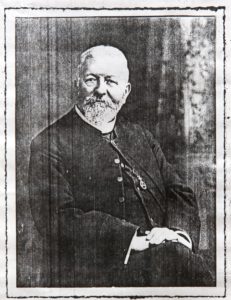
Published: 18/09/2019
Updated: 13/01/2023
This is the 10th in our series of 12 monthly blogs by Friends’ Trustee Dr John Morgan Guy. This month we discover WJ Coussmaker Lindsay, and his intimate connection with St Mary’s, Llanfair Kilgeddin, in Monmouthshire.

Wynfield, David Wilkie; Sir Coutts Lindsay Bt. (1824-1913) (c) Royal Academy of Arts / Photographer credit: Prudence Cuming Associates Limited.
The answer is that they were all members of one quite remarkable family.
The Scottish peer was Alexander, 25th Earl of Crawford and 8th Earl of Balcarres (1812-80), art collector, art historian, and owner of one of the most impressive libraries in the country. The Irish bishop was his great-uncle, the Hon. Charles Lindsay, Bishop of Kildare & Dean of Christ Church Cathedral, Dublin from 1804-46. The Art Gallery owner was another of that bishop’s great-nephews, Sir Coutts Lindsay (pictured left), founder and owner of London’s Grosvenor Gallery from 1877 to 1890, a gallery which through its patronage of certain artists, then regarded as avant-garde, created what has been called ‘a seismic change in the conventional Victorian art world’.
The Chief Constable (of Glamorgan, from 1867-91) was Henry Gore Lindsay, second cousin of Lord Balcarres and Sir Coutts; and the country parson – and subject of this essay – was Henry’s brother, Coussmaker, rector of Llanfair Kilgeddin in Monmouthshire, a church which came into the care of FoFC in 1989, after threats of its demolition had been successfully defeated.
The visual arts and their promotion were in the genetic make-up of the Lindsays. The Grosvenor Gallery, in New Bond Street, boldly exhibited the works of artists of the calibre of G F Watts, James McNeil Whistler and Edward Burne-Jones, and challenged the conventionality of the Royal Academy. It was here that key artists of the Pre-Raphaelite and Aesthetic Movements met and mingled. And we can surmise too that it was here that the Revd WJ Coussmaker Lindsay (his unusual name was his grandmother’s maiden name), through his cousin, met the two men with whom he was to be closely associated — the architect John Dando Sedding and the artist Heywood Sumner.


WJ Coussmaker Lindsay (left) had grown up in Ireland, at his father’s home, Glasnevin House near Dublin. He graduated from Trinity College, Dublin, and followed his grandfather into the ordained ministry of the Anglican Church. He was chaplain to his cousin, Lord Balcarres, and then, in 1857, came to Monmouthshire as rector of Llanvaches. His patron was Lord Tredegar, whose daughter Ellen was married to his brother Henry. Subsequently it was Ellen’s brother, the 1st Viscount Tredegar, who preferred him to the church with which he is most closely associated, Llanfair Kilgeddin, and here he remained until his death.
Very early in his incumbency Lindsay set about the restoration of his parish church, employing Sedding as his architect (1873-76). The nave was extended westwards, and the whole largely rebuilt as we see it today. Lindsay was much influenced by the Tractarian and early Anglo-Catholic Movements, and as a result saw to it that the fragments of medieval glass and chancel screen were carefully conserved. Then in 1885 his wife Rosamond Emily (née Mundy) died, and Lindsay determined upon a scheme of interior decoration in St Mary’s that would be her memorial.

This time he turned to another associated with his cousin’s gallery — the artist Heywood Sumner — and between 1888 and 1890 created what is the great glory of the church — the series of sgraffito panels inspired by the words of the Benedicite: the Song of Creation. Sumner (1853-1940) had connections with this part of Monmouthshire; his grandfather had been Bishop of Llandaff for a short time, residing at Llansantffraed close to Llanfair. The scenery and landscape of the area feature prominently in Sumner’s compositions.
There is also a moving reference to the late Rosamond Emily Lindsay; in the panel inspired by the words O ye children of men, Bless ye the Lord: Praise Him and magnify Him for ever (pictured above) is depicted a grief-stricken priest, clad in robes which recall George Herbert’s Country Parson, kneeling beside the bier carrying the corpse of his dead wife. Above, held by an angel, is a panel with scriptural words familiar from the Burial Service: I heard a voice from heaven saying Blessed are the dead which die in the Lord…
This wonderful series of panels was carefully and skilfully conserved in 2006-7 in memory of Lord Jenkins of Hillhead (Roy Jenkins), another Monmouthshire man. Art and craft, love and grief, faith and devotion, are uniquely interwined here at Llanfair Kilgeddin - and make any visit to this church a memorable experience.
Get directions and visit St Mary's.
